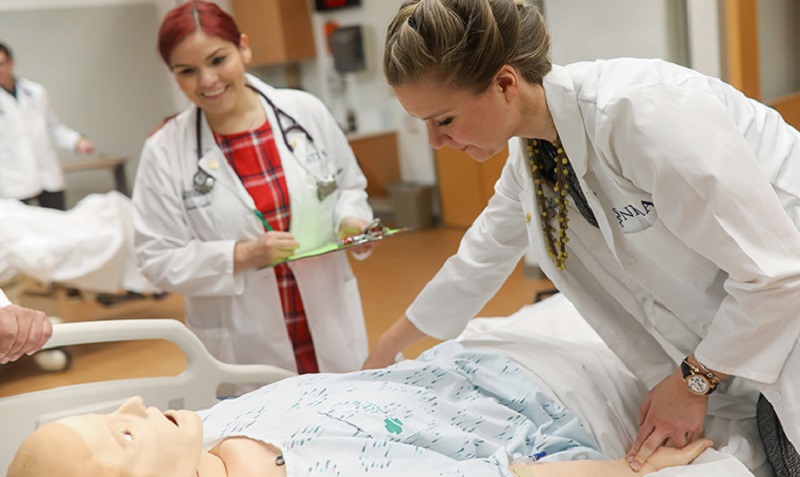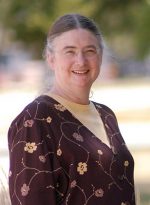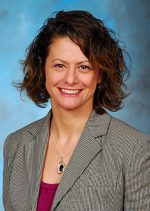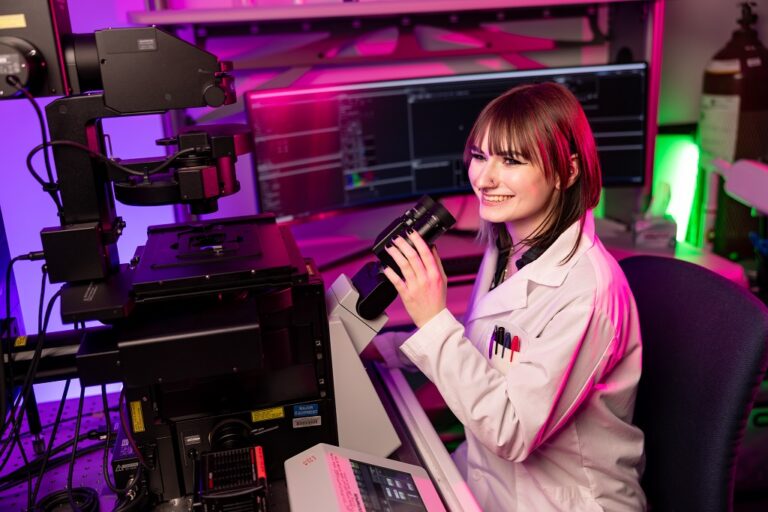Balancing the scales
School of Medicine & Health Sciences committed to greater gender equity in medicine and research

“My dad went to med school when I was five, so I watched him going through that process,” said Sarah Lewis, a second-year medical student at the UND School of Medicine & Health Sciences (SMHS), describing how she was encouraged to explore medicine herself from an early age. “That’s what pushed me toward science. But even before that I was interested in the idea of being a doctor.”
Melissa Johnson nodded in understanding.
“No one discouraged me from science,” added Johnson, a first-generation college student who used to obsess over television programs like William Shatner’s Rescue 911 and Bill Nye the Science Guy. “I’ve always been interested in medicine. I volunteered as an EMT in high school, went to college for a chemistry degree, and here I am.”
And so the conversation went as Lewis, Johnson, and their second-year colleagues Becky Dravland and Andie Taborsky reflected on how times have changed for women pursuing careers in medicine and the biomedical sciences.
They are part of the first cohort of matriculating medical students in American history to be comprised of more females than males (when all 150+ schools recognized by the Association of American Medical Colleges are combined).
Hidden figures
But while this group of women struggled to remember an instance where they were not encouraged to explore the sciences, it wasn’t always so.

Medical doctor and research scientist Mary Ann Sens, the chair of UND’s Department of Pathology and medical examiner for Grand Forks County, recalls a time when it felt like much of the world was hostile to the notion of women practicing either medicine or laboratory science.
“I was absolutely dissuaded from going into science and medicine by some people,” explained Sens, who described classified ads in the South Carolina newspapers of her youth that specified “Help Wanted: Ladies” and “Help Wanted: Men.”
Very rarely did job openings in the sciences or healthcare indicate they were looking for female applicants.
“When I went to medical school the [gender] split was 95 to five in favor of men,” she continued. “It stayed that way for a long time. I heard several comments that I was taking a man’s place in the field and so on. But I just persevered. I intended to go into science early on. My parents were very supportive of education for women. They insisted that my siblings and I all go to college. I’m happy with the direction things have gone [with more females entering the sciences], but it hasn’t been far enough.”
Pipeline problem?
Referencing her colleagues in UND’s Department of Biomedical Sciences, Sens added that there are far more women pursuing graduate degrees in the biomedical sciences than a few decades ago.

Helping recruit and retain females into the research sciences are folks like Sens and Catherine Brissette, an associate professor of biomedical sciences at the SMHS who has built a career studying the pathology and diagnosis of Lyme disease and other vector-borne illnesses.
Noting how her own graduate school advisors were female, Brissette applauds the growth she has seen in young women pursuing science and medicine, but notes that there still aren’t a lot of female professors at colleges and universities.
“In terms of the undergrads who come in I get plenty of interested young women,” mused Brissette, who began at UND as a single mother with a 17-month old baby and was one of only a handful of women in a department of more than 40 faculty. “There is a point where many women fall out of the sciences, but it’s not at the college level. A lot of it might simply boil down to the traditional questions of family and work-life balance. And that lack of [female] role models may cause young women to drop out of the pipeline. That’s why it’s so important for women in positions of power and prestige to ‘send the elevator back down’ and provide encouragement and mentoring to the next generation.”
While such scenarios are in line with what is happening at many schools nationally, the SMHS seems to be performing better than average in this regard. Three of the seven members of Dean Joshua Wynne’s senior management team and four out of 10 full-time departmental chairs are women.
“Not bad, I’d say, although all of our clinical departmental chairs are men,” Dr. Wynne admitted. “Taken all together, six of 21 [29 percent] of our deans and chairs at the School are women—still not where I’d like it to be, but almost double the 17 percent national rate for medical schools. And of the 10 people who report directly to me, four are women.”
Building relationships
The School’s attempt to achieve greater gender parity at the administrative level reflects the fact that not only are there more women pursuing medicine today, but that the American healthcare workforce as a whole—from athletic trainers, nurses, and physician assistants to therapists and technicians—is already predominantly female.
But despite the fact that things have gotten much easier for women interested in such careers, the environment can still pose challenges unique to female medical students.
Taborsky described her time working as a certified nurse assistant when she was younger. “I actually got a bit frustrated with some patients,” Taborsky said. “People—often older men—would ask me, ‘Are you going to nursing school?’ and it frustrated me that they assumed that I was going to be a nurse just because I was a female.”
For Dravland, whose father was also in medicine, it’s that sort of lingering bias among persons of an older generation that compels many young women to work even harder.
“I think there is an unconscious pressure for females to push ourselves and improve ourselves when we know we still might be taken less seriously as professionals,” she said.
“In general, still we have to consider a lot more ‘life’ stuff as we make these decisions about specializing, residency, and fellowship,” added Lewis. “By the time you’ve completed all of that you’ll be considered ‘advanced maternal age.’ You have to take that into account.”
Although gender still matters in an evolving healthcare workforce, says first-year medical student RaMae Norton, it is perhaps today less of an issue than is training. Bedside manner, communication, and relationship building are increasingly emphasized in medical schools for all students.
All of this is “not only about gender but generation and the changing doctor-patient relationship,” Norton said. “In my experience, if physicians have an honest relationship with patients and take time with them, they’re likely to have more open conversations, maybe better medication compliance and so on, regardless of gender. That relationship itself should be the focus.”
About the author
Brian James Schill is the assistant director of the Office of Alumni and Community Relations at the University of North Dakota School of Medicine & Health Sciences.


